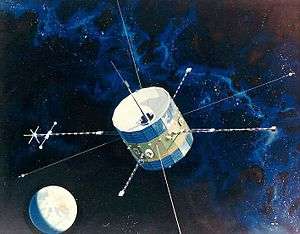ISEE-1
|
ISEE-1 | |
| Names | Explorer 56, ISEE-1 |
|---|---|
| Mission type | study Earth's magnetic field and the solar wind |
| Operator | NASA, ESA |
| COSPAR ID | 1977-102A |
| SATCAT № | 10422 |
| Spacecraft properties | |
| Launch mass | 340 kg (750 lb) |
| Start of mission | |
| Launch date | 13:53, October 22, 1977 |
| Rocket | Delta |
| Launch site | Cape Canaveral AFS |
| End of mission | |
| Decay date | September 26, 1987 |
| Orbital parameters | |
| Reference system | Geocentric |
| Eccentricity | 0.91 |
| Perigee | 1.04 Earth radii |
| Apogee | 23 Earth radii |
| Inclination | 28.76° |
| Period | 3556.8 min |
| Epoch | October 22, 1977 |
The International Sun-Earth Explorer 1 (ISEE-1, or Explorer 56) was a 340-kg space probe used to study magnetic fields near the Earth.[1] ISEE-1 was a spin-stabilized spacecraft and based on the design of the prior IMP (Interplanetary Monitoring Platform) series of spacecraft.[1] ISEE-1 and ISEE-2 were launched on October 22, 1977, and they re-entered on September 26, 1987.[2][2]
Mission

The space probe was part of a program consisting of three spacecraft: a mother/daughter pair (ISEE-1 and ISEE-2) and the ISEE-3 spacecraft (later renamed to International Cometary Explorer). The program was a cooperative mission between NASA and ESRO (later ESA) designed to study the interaction between the Earth's magnetic field and the solar wind. At least 32 institutions were involved, and the focus was on understanding magnetic fields.[1] ISEE-1 (a.k.a. Explorer 56) and ISEE-3 were built by NASA, while ISEE-2 was built by ESA. All three had complimentary instruments supported by the same group of over 100 scientists.[1]
Orbit
ISEE-1 and ISEE-2 remained near the Earth. ISEE-3 was the first spacecraft to be placed in a halo orbit at the Earth-Sun Lagrangian points L1 and it was later launched into a heliocentric orbit.[1]
See also
References
- 1 2 3 4 5 "ISEE - eoPortal Directory - Satellite Missions". Directory.eoportal.org. Retrieved 2014-03-12.
- 1 2 "NASA - NSSDC - Spacecraft - Details". Nssdc.gsfc.nasa.gov. Retrieved 2014-03-12.
